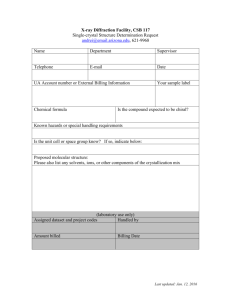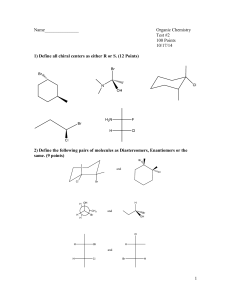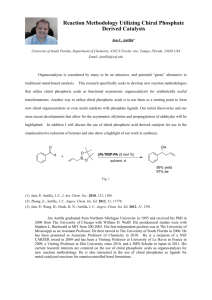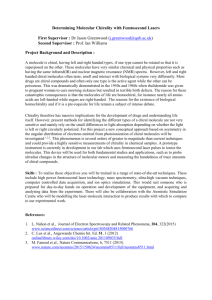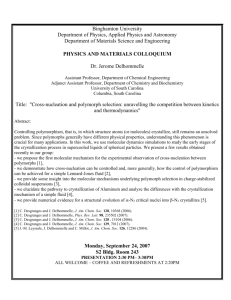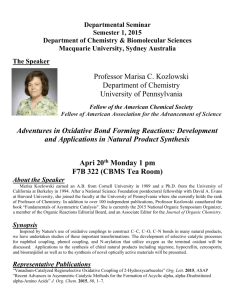Edgars Sūna. Chiral 1,2,3,4-Tetrahydroisoquinolines Synthesis and
advertisement
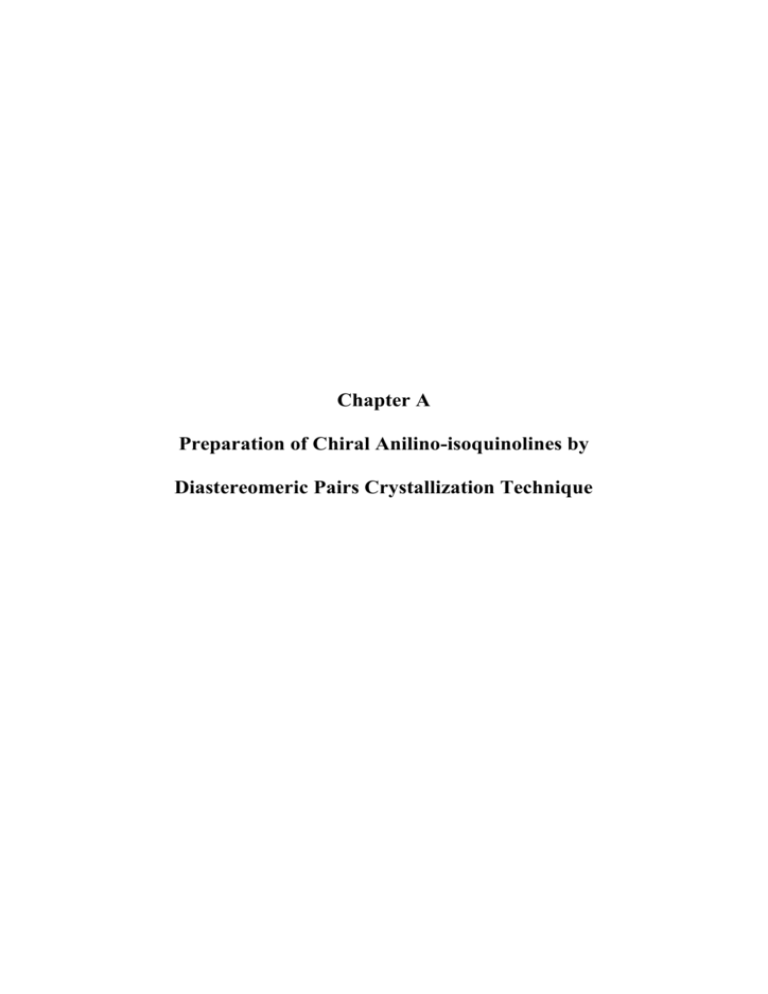
Chapter A Preparation of Chiral Anilino-isoquinolines by Diastereomeric Pairs Crystallization Technique Racemates resolution via diastereomer pairs crystallization technique is the most straightforward route to optically active amines.1 In this type of reaction, substrate (racemic amine) is treated with one enantiomer of a chiral substance (the resolving agent, chiral acid). Diastereomer pairs usually are ionic (diastereomeric salts) or covalent. The method is fairly inexpensive because the chiral reagent can be recovered by a simple acid-base extractive work-up. On the other hand, resolution success often requires extensive screening of various chiral acids as well as careful adjustment of crystallization conditions. The synthetic problem, however, becomes technically easier in the cases when resolution of structurally related substrates has already been reported. Since tetrahydroisoquinoline is a principal constituent of various alkaloids and drugs, a number of chiral reagents have been applied for the resolution of racemates. Among them, tartaric acid and its O-substituted analogues as well as diacetone-2keto-L-gulonic acid are most frequently used1b for preparation of diastereomeric salts. For example, chiral isoquinoline CAPTIQ, so far the best chiral proton donor for deracemization of various amides,2 is commercially available as a salt with L(+) tartaric acid (Aldrich). Use of tartaric acid for resolution of other 1-anilino-1,2,3,4tetrahydroisoquinolines3 stimulated us to employ this technique for the preparation of various CAPTIQ analogues as potential asymmetric proton donors. 1. Synthesis of racemic 1-anilino-1,2,3,4-tetrahydroisoquinolines. Optimization of Bischler-Napieralski cyclization. There are a number of methods for isoquinoline ring construction4 and the most frequently used processes are summarized in Table A1. 4 Table A1. General methods for isoquinoline ring construction. "Disonnection approach" C C Reaction C N Products Bischler-Napieralski 3,4-dihydroisoquinolines Pictet-Spengler 1,2,3,4-tetrahydroisoquinolines C C C N C C Pomeranz-Fritsch isoquinolines Schlittler-Muller isoquinolines C N Bischler-Napieralski cyclization is somewhat more attractive compared to the alternatives because it employs relatively easily available substituted benzoic acids A1 as the starting material. Moreover, the cyclization affords C=N double bond containing 3,4-dihydroisoquinolines A3, that potentially can be reduced in an asymmetric way yielding chiral or enantiomerically enriched products A4. 1. Achiral reduction 2. Racemate resolution COOH X A1 NH O X BischlerNapieralski N * NH X X cyclization A2 X = NR1R2, NO2, Hal A3 Asymmetric reduction A4 Bischler-Napieralski cyclization proceeds via initial formation of hydrochloric salts of imidoyl chloride A5 using POCl3, PCl5 or SOCl2 as a reagent. Subsequent loss of hydrogen chloride generates imidoyl chloride species A6 which is in equilibrium with the corresponding nitrilium salt A7.5 In the presence of Lewis acids, such as SnCl4, ZnCl2 or POCl3, PCl5 and SOCl2, nitrilium salt undergoes cyclization affording 3,4-dihydroisoquinolines A8. 5 Scheme A1. R2 R1 R1 R1 NH O - HCl + R2 Cl R NH Cl R R2 N Cl R A6 A5 R1 R1 + R2 R NH Cl Lewis acid R1 SnCl4 + N R2 - Cl Cl R2 + N R A8 A7 R A9 It was also shown that related nitrilium salts A7 prepared by direct alkylation of the corresponding nitriles A9 yield 3,4-dihydroisoquinolines A8 in the presence of various Lewis acids (SnCl4, ZnCl2).6 Employing P2O5 and polyphosphoric acid esters as dehydrating agents resulted in the formation of corresponding imidoyl phosphates as the intermediates. Since our objective was the synthesis of various 1-anilino-1,2,3,4tetrahydroisoquinolines A4 (X=NR1R2), choice of the proper N-protecting group in phenethylamides A2 (X=NR1R2) was critical, because unprotected aniline NH2 group obviously does not survive harsh Bischler-Napieralski cyclization conditions. Moreover, it was reported that even cyclization of mono-N-protected anilino-phenethylamides (N-acetyl and N-tosyl) failed to give the desired 3,4dihydroisoquinolines.3a A family of various N-bis-protected -phenethylamides A11A14 was therefore readily prepared from isatoic anhydride A10 in order to determine the best protecting group for the cyclization. 6 Scheme A2. O O O N H HN PhCH2CH2NH2 O O O O A11 Et3N / PhH 76 % A10 73 % N O NH2 dioxane, reflux 75% after crystalliz. O O HN HN CH3I/ DMF Na2CO3 O TosCl/Py 24 h O O PhCH2CH2NH2 N O CH3 dioxane, reflux 89 % HN Me N Tos A12 1. PhCH2Br /CH2Cl2 O Me Na2CO3 / H2O NH 2. HCl / Et2O, 87% HN O Me + NH Ph Cl A13 HN AcCl / Et3N 85% O Me N Me O A14 Electron-withdrawing N-protecting groups were chosen assuming that an electron-deficient 1-aryl substituent could polarize an amide carbonyl group, thus facilitating formation of the corresponding imidoyl chloride A6 and, consequently, the nitrilium intermediate A7 (Scheme A1). An alternative approach to aniline protection is the use of appropriate functionality that is resistant to cyclization conditions and can afterwards be easily converted to anilino group. A suitable candidate is a nitro group that can be selectively reduced to aniline7 in the presence of 3,4-dihydroisoquinoline C=N bond as well as halogen, that can be replaced by various amines under miscellaneous conditions.8 Both nitro and halogen-substituted -phenethylamides A15 and A16 were easily prepared from the corresponding benzoic acids. X COOH 1. SOCl2 HN X 2. PhCH2CH2NH2 NaOH/ H2O X = Cl, Br, NO2 -Phenethylamides A11-A16 O A15 (X=NO2) A16 (X=Cl, Br) were subjected to Bischler-Napieralski cyclization and the results are summarized in Table A2. 7 Table A2. Bischler-Napieralski cyclization of various -phenethylamides A11-A16. N NH O X X A11-A16 A17-A21 Entry Substrate X Dehydrating agent Conditionsa Product Yield (%) 1 A13 P2O5 6h A17b 16 2 3 A14 A12 N(CH3)CH2Ph · HCl N(CH3)Ac N(CH3)Tos 24h 20h A18 0 30 4 5 A11 A11 N-phthalyl N-phthalyl P2O5 P2O5 or POCl3 P2O5 PCl5 24h A19 A19 20 73 6 7 A15 A16 NO2 Cl, Br P2O5 P2O5 A20 A21 72 70 30 min. reflux, CHCl3, then SnCl4, 4h 5h 20h (a) Unless indicated otherwise, all cyclizations were performed in xylenes under reflux. (b) N-debenzylated product A17 (X=NHCH3) was isolated. Initially, N-benzyl group was employed for N-methyl aniline protection (entry 1). The tertiary amine was converted to hydrochloric salt A13 (See Scheme A2), making the aryl group electron-deficient and thus favoring imidoyl phosphate A6 formation (see Scheme A1). Also, it was expected that ammonium salt would be less prone to various side-reactions with an excess of phosphorylating agent. Surprisingly, instead of the anticipated N-methyl-N-benzylaniline from the oily dark red reaction mixture, the N-debenzylated product A17 was obtained in a low 16% yield. Isolation of deprotected product A17 suggested that phosphorylation side-reaction and subsequent phosphono-anilide degradation is responsible for the low chemical outcome. Consequently, N-benzyl group can not be employed for aniline protection in Bischler-Napieralski cyclization. It was also found that the N-acetyl protected substrate A14 (entry 2) is unreactive under standard conditions, while N-tosyl analog A12 afforded the desired isoquinoline A18 in a low 30% yield (entry 3). Similarly, Nphthalyl aniline A11 gave only 20% of the desired isoquinoline A19 under standard conditions (entry 4), however, the yield was significantly increased employing modified reaction conditions (entry 5). Thus, treatment of -phenethylamide A11 with 8 excess PCl5 in boiling CHCl3 for 30 min. resulted in the formation of a yellow precipitate, which upon addition of Lewis acid (SnCl4) turned brick-red. Color change indicates the formation of cyclized product A19, because 3,4-dihydroisoquinolines usually are intensely red-colored in acidic media. The reaction was refluxed for an additional 4 hours to complete cyclization and the desired N-phthalyl-isoquinoline A19 was isolated in 73% yield. The cyclization was readily scaled-up to 85 g without a drop in yield and consequently, the N-phthalyl protecting group combined with modified Bischler-Napieralski cyclization conditions can be employed for preparative scale synthesis of 1-anilino-3,4-dihydroisoquinoline. In contrast to N-bis-protected anilines (entries 1-4), cyclization of nitrobenzene A15 does not suffer from side-reactions and proceeds relatively fast, evidently because of a strong electron-withdrawing nitro group effect. The desired nitro-isoquinoline A20 was obtained in 72% yield after 5h under standard conditions (entry 6). The same level of conversion (ca. 70%) for bromo- and chloro-substituted -phenethylamides A16 was achieved after a considerably longer reaction time (20h, entry 7). 3,4-Dihydroisoquinolines A21 (X=Cl, Br) are especially useful because a number of methods for direct aryl halogen displacement by various amines have been reported.3a,8 Since -phenethylamides A11, A15 and A16 are almost equally good Bischler-Napieralski cyclization substrates, overall reaction sequence to 1-anilino-3,4dihydroisoquinoline A22 was examined for each amide A11, A15 and A16 in order to evaluate the most efficient route to the product (see Scheme A3). Thus, cyclization of N-phthalyl-aniline A11, followed by hydrazine hydrate mediated protecting group cleavage,9 afforded the desired 3,4-dihydroisoquinoline A22 in 37% overall yield. Higher overall yield (ca. 50%) was achieved using the nitro-substituted phenethylamide A15 (see Scheme A3). In this sequence, the nitro group was selectively reduced in the presence of C=N double bond in 68% yield. The most efficient route to 1-anilino-3,4-dihydroisoquinoline A22 turned out to be the BischlerNapieralski cyclization of 2-chloro(or bromo)phenyl--phenethylamides A16, followed by halogen displacement with liquid ammonia or lower alkylamines3a affording the desired heterocycle A22 in 61% overall yield. 9 Scheme A3. HN O O N O PCl5 / CHCl3 N N SnCl4 O A11 H2NNH2 H2O EtOH 50% O 73% A19 HN N O NO2 N Fe / HCl P2O5 / xylenes NO2 5h, reflux NH2 EtOH-H2O 1:1 72% 68% A20 A15 HN O NH3 Cu/CuCl 700 C, 5 days 87% N P2O5 / xylenes Br A22 Br 20h, reflux 70% A16 A21 The reaction sequence A16A22 technically is fairly simple and was easily scaled-up (25 g amide A16 loading) without drop in chemical yields. The method was also employed for the synthesis of various substituted N-methylanilines A26a-d from the corresponding ortho-chlorobenzoic acids A23a-d (Scheme A4). Scheme A4. Cl COOH 1. SOCl2 2. PhCH2CH2NH2 NaOH/ H2O Z A23a-d HN N O P2O5 /xylenes MeNH2 (liquid) Cl Cl 20h, reflux Cu/CuCl Z Z A25a-d A24a-d N NHCH3 Z a: Z = H b: Z = NO2 c: Z = CF3 d: Z = SO2Me A26a-d Benzoic acids A23a-c are commercially available, however, trifluoromethylbenzoic acid A23c is relatively expensive for use as a starting material.A Therefore, it was prepared in 2 steps from chlorobenzene A27 (Scheme A5). (A) Aldrich, 18 DM/g 10 Scheme A5. Cl Cl Cl Br Br2 / SbCl5 n-BuLi / TMEDA Cl2 CF3 CF3 A27 A28 Cl Li - 100 o C CO2 / COOH H+ 88% CF3 CF3 A29 A23c > - 500 C N TMEDA: N side-reactions F3 C Bromination was performed according to the literature procedure10 followed by selective lithium-bromine exchange in A28.11 Low temperature (-100 0C) is crucial to achieve chemoselectivity in the metalation reaction as well as to avoid side-reactions via dehydrobenzene, which are dominant at temperatures above –50 0C. Additional stabilization of the intermediate A29 can be achieved by using bidentate ligand TMEDA, frequently used as a complexing agent for various organolithium derivatives.12 Finally, carboxylate was introduced by treatment of the aryllithium intermediate A29 with CO2 (dry ice), yielding the desired benzoic acid A23c in 52% overall yield. Methylsulfonyl-benzoic acid A23d was prepared in 3 steps from orthochlorobenzoic acid A23a via formal reduction13 of chlorosulfonylbenzene A3014 to the corresponding sulfinic acid A31, followed by alkylation of “soft” nucleophilic sulfur by MeI.15 Scheme A6. Cl Cl COOH COOH HSO3Cl 1. PhSH / Et3N EtOAc Cl Cl COONa COOH + 2. NaOH A23a SO2Cl SO2Na SO2Na A31 A30 MeI / MeOH 63% Cl Cl COOMe COOH + SO2Me SO2Me A23d 5 : 2 NaOH / H2O 92% 11 All substituted 1-anilino-3,4-dihydroisoquinolines A20, A22 and A26a-d were conveniently transformed to the desired racemic 1,2,3,4-tetrahydroisoquinolines employing reduction with NaCNBH3 in acetic acid16 (70-85% yield). NaCNBH3 N X NH X AcOH Z Z A20, A22, A26a-d A31: X = NO2, Z = H A32: X = NH2, Z = H A33a: X = NHCH3, Z = H A33b: X = NHCH3, Z = NO2 A33c: X = NHCH3, Z = CF3 A33d: X = NHCH3, Z = SO2Me 2. Racemates resolution by crystallization of diastereomeric tartrates. Tartaric acid was chosen for the resolution because preparation of structurally similar, optically pure 1-(5-chloro-2-methylamino)phenyl-1,2,3,4-tetrahydroiso- quinoline (CAPTIQ) via crystallization of diastereomeric tartrates has already been reported.3a Moreover, tartaric acid mediated racemate resolution succeeded also in the case of N-unsubstituted diamine A32.3b Contrary to reported successful resolution of diamine A32, we were unable to achieve even smallest enantiomerical enrichment by the crystallization of tartrates from ethyl alcohol and other solvents (methanol, acetone, EtOAc etc.). Moreover, all attempts to prepare chiral diamine A32 using O,O-dibenzoyl tartaric acid, successfully applied for racemic piperidine A34 resolution,17 as well as D-(+)camphorsulfonic acid (efficient in case of amine A35)17 in various solvents, failed. Evidently, the difference in diastereomeric salt solubility is too small for the separation by selective crystallization. Neither was any diastereomer separation observed in the case of nitro-isoquinoline A31 and N-tosylanilide A36 employing tartaric, O,O-dibenzoyltartaric and camphorsulfonic acids in various solvents. O O NH NH NHCH3 A34 NH2 NO2 A35 1. Tos-Cl / Py 53% N A22 2. NaCNBH3 / AcOH 74% NH H N S O O A36 In contrast, crystallization of diastereomeric tartrates derived from Nmethylanilino-1,2,3,4-tetrahydroisoquinolines A33, was effective for resolution of 12 unsubstituted and CF3-substituted diamines A33a and A33c, respectively. Thus, two crystallizations of corresponding tartrate salts from ethyl alcohol, after workup, afforded single enantiomers of potential chiral proton donors with > 99.5% enantiomerical purity according to HPLC on the chiral stationary phase (CSP). Scheme A7. * NH OHD-(-)-Tartaric acid (-) tartrate EtOHabs. NHCH3 Amberlite IRA-401 NH less soluble NHCH3 X > 99.5 % ee (-)A33a: X = H (-)A33c: X = CF3 L-(+)-Tartaric acid EtOHabs. X (±)A33a: X = H (±)A33c: X = CF3 * NH OH- (+) tartrate Amberlite IRA-401 NHCH3 X > 99.5 % ee (+)A33a: X = H (+)A33c: X =CF3 No difference in the solubility of diastereomeric tartrates, however, was observed in the case of poorly soluble nitro-isoquinoline A33b and, as a consequence, all precipitate crops, according to HPLC on CSP, contained 1:1 mixture of diastereomeric tartrates. Similarly, methylsulfonyl-isoquinoline A33d was not resolved using various chiral acids and different solvents. Lack of separation in this case is hard to explain in view of the easy resolution of CF3-substituted and unsubstituted analogs A33a and A33c. Thus, only moderate success has been achieved in the preparation of chiral diamines by diastereomeric salt crystallization. Moreover, it was clearly shown that the process is highly substrate-dependent and even small changes in substrate structure affect the efficiency of resolution. Consequently, racemates resolution by crystallization technique can not be employed in the design of a general method for the synthesis of chiral 1,2,3,4-tetrahydroisoquinolines. 13 3. Chiral diamine preparation via (R)-O-acetylmandelic acid amides. Potential solution of the problem could be synthesis of a key intermediate by the resolution method and subsequent chemical transformations of optically pure material. The most appropriate candidates for the key structure are nitro- and aminophenyl-1,2,3,4-tetrahydroisoquinolines A31 and A32. Because all attempts to resolve these substrates by diastereomeric salts crystallization technique have failed so far, it was decided to employ an alternative resolution method. Thus, another approach frequently used for racemates resolution is the introduction of a covalently bonded chiral auxiliary, separation of diastereomers by chromatography or crystallization technique and, finally, the removal of the chiral auxiliary. It has been recognized that multiple interactions between the resolution substrate and resolving agent are essential for successful resolution. Consequently, chiral acid should possess an aromatic ring and an additional functional group besides the acid functionality.1c A promising candidate is mandelic acid and its O-Me and OAc substituted analogs, that have been widely used for racemic amines resolution.18 Moreover, successful application of (R)-O-acetylmandelic acid as a chiral auxiliary for HPLC separation of 1-phenyl-1,2,3,4-tetrahydroisoquinolines19 urged us to examine this commercially available resolving agent for the resolution of key intermediates A31 and A32. Treatment of nitro-isoquinoline A31 with commercially available (R)-Oacetylmandelic acid in the presence of dicyclohexylcarbodiimide gave amide A37 as a 1:1 mixture of diastereomers: O NH NO2 O R-(-)-O-Acetylmandelic acid N O NO2 DCC / DMAP(cat.) CH2Cl2 75% A31 A37 All attempts to separate A37 diastereomers by flash chromatography on silica gel failed. As amide A37 is solid, crystallization was applied in the hope that diastereomers have difference in solubility. Indeed, two crystallizations from ethyl acetate - hexanes gave a single amide A37 diastereomer in 31% yield with (R,R) absolute configuration according to X-ray analysis. 14 (R) O H O N H O O2N (R) (R,R)-A37 With the single diastereomer (R,R)-A37 in hand, the racemization-free removal of the chiral auxiliary became a crucial issue. Initially, hydrolytic methods were employed to remove the O-acetylmandelic auxiliary. Thus, amide (R,R)-A37 was heated under reflux in 6 N hydrochloric acid for 1 hour and the isolated desired isoquinoline (R)-A38 was partially racemized.B O O N H O NO2 (R,R)-A37 6N HCl 50% dioxane NH H NO2 46% chem. yield 54% ee (R)-A38 Although use of less concentrated hydrochloric acid (1N) resulted in a lower degree of racemization (67% ee), the chemical yield was too poor (10%) to utilize this method on a preparative scale. Racemization apparently took place via an isoquinoline ring opening-ring closure sequence in strongly acidic media, however, no attempts were made to study the process in detail. Instead, the amide bond reductive cleavage to the corresponding amine and aldehyde (alcohol) was examined.20 It should be noted that the scope of potentially useful reducing agents for amide bond cleavage was diminished by low substrate solubility in common solvents such as THF, ether and toluene. The (B) The optical purity of products was determined by HPLC on CSP. 15 solubility of (R,R)-A37 in CH2Cl2 allowed to perform the reduction with DIBAL-H (Scheme A8).21 Scheme A8. NH H NO2 DIBAL-H CH2Cl2 O - 78oC O (R)-A38 44% chem. yield 45-47% ee N H O NO2 (R,R)-A37 LiBH4 THF / MeOH reflux NH H NH2 49% chem. yield (R)-A32 75% ee Surprisingly, product isoquinoline A38 isolated in 44% yield, was again partially racemized. Optical yield did not improve even when the reaction was performed at –100 0C (by DIBAL-H addition to a melting surface of the reaction mixture). As expected, nitro group was left unaffected. Partial racemization (75% ee) was also observed using LiBH4 in refluxing THF-methyl alcohol mixture.22 In this case, nitro group was reduced and anticipated diamine A32 was obtained in 49% chemical yield (Scheme A8). Since use of other reducing agents (LiAlH4, LiAlH(t-BuO)3, Red-Al)20 was limited by the poor solubility of the amide A37, it was expected that the conversion of nitro group to amino could solve the solubility issue. Nitro group hydrogenation was performed in acetic acid and resulted in the formation of anticipated aniline A39 accompanied by an unexpected product of acyl group migration A40. 16 O O O N O NO2 O H2 / (5%) Pd - C AcOH NH N O NH2 + NH O O O 38% 62% (R,R)-A37 R,R-A40 (R,R)-A39 AcOH 1 H-NMR experiments in acetic acid-d4 showed that 50% of aniline A39 has been already rearranged to isoquinoline A40 after 8h at 20 0C, while complete acyl group migration was observed after 64 h at room temperature (ca. 4% of starting material A39). Anilide A40 formation was rather unexpected because O-acetylmandelyl group migrates from the basic isoquinoline nitrogen to the much less basic aniline. It 17 can be rationalized either by sterical factors or by assumption that the driving force for this rearrangement is protonation of isoquinoline as the more basic amine in acidic media. It is believed that rearrangement occurs via a cyclic tetrahedral transition state A41: Ph Ph O N O N CH3 O H2N O O OH NH CH3 NH H N Ph O O CH3 O A40 A41 A39 Lack of O-acetylmandelyl group migration product A40 in acetonitrile-d3 (polar aprotic solvent) and methanol-d4 (polar protic solvent) after 18h at 70 0C followed by 72h at 20 0C suggests that acidic media is crucial for the rearrangement. This supports the assumption that the process driving force is protonation of the more basic isoquinoline nitrogen. Absolute configuration of amide A40 isoquinoline carbon was not determined with independent methods; nevertheless, retention of R-configuration was assumed because the rearrangement does not involve the chiral center. To verify the structure of the amide A40, it was decided to prepare it using an alternative pathway (Scheme A9). Besides, in the case of successful amide A40 diastereomers separation, cleavage of the O-acetylmandelic auxiliary would cause fewer concerns because chiral N-unsubstituted isoquinolines do not racemize in acidic media. Scheme A9. R-(-)-O-Acetylmandelic acid N NH2 N DCC / DMAPcat. CH2Cl2 A22 O NH O 96% yield O NH NaCNBH3 AcOH crystallizations > 99% ee 95% chem. yield H NH2 (S)-A32 NH 1 N HCl 4h, reflux O O 82% yield A42 NH O NH A40 O NH O O (S,R)-A40 18 Since single diastereomer of nitro-amide A37 could be obtained by crystallization technique, this approach was also applied to optical purification of A40. Two crystallizations afforded a single diastereomer with (S,R) absolute configuration according to X-rays analysis: O H O NHNH O (R) H (S) (S,R)-A40 Hydrolytic cleavage of O-acetylmandelic auxiliary in refluxing 1N HCl for 4 hours proceeded without the complications encountered in the case of amide (R,R)A37, and desired optically pure diamine (S)-A32 was isolated in 95% yield (see Scheme A9). Thus, O-acetylmandelic acid turned out to be highly efficient chiral auxiliary for resolution of racemic anilino-isoquinoline A32. From the other hand the chiral reagent is too expensiveC to be employed for preparative scale synthesis. This shortage was overcome by combination of chiral auxiliary mediated racemates resolution with diastereomeric salts crystallization technique. Thus, optically pure (S)diamine A32 was treated with L(+) tartaric acid and the resulting salt used as the seed in crystallization of racemic diamine A32 salt with L(+)-tartaric acid. Seed crystals NH L (+) Tartaric acid NH2 rac-A32 NaOH 4-6 crystallizations CH2Cl2 of L(+) tartrate NH H NH2 ~ 10% chem. yield > 99% ee (S)-A32 (C) Aldrich, 21.66 DM / g. 19 Usually 4 to 6 crystallizations with seed crystals were required to obtain enantiomerically pure diamine A32 in ca. 10% overall chemical yield. The method is relatively inexpensive because once the seed crystals are generated they can be retrieved after a successful prep-scale crystallization routine. Moreover, both chiral tartaric acid and diamine can be recovered by a simple acid-base extractive workup. At the same time, the procedure is fairly laborious and since diastereoselective crystallization is a relatively slow process, it takes 2-3 weeks to complete the whole crystallization cycle from racemate to pure single enantiomer. Another important drawback is that the method gives access only to optically active N-unsubstituted anilino-3,4-dihydroisoquinoline A32 and various derivatives that could be prepared from this chiral diamine. Meanwhile, analogues such as 1-aryl-piperidines A34, A35, as well as various 1-naphthyl-isoquinolines A43, apparently would require development of different resolution conditions, which is, as mentioned above, a laborious and time consuming process. O NH O NH NHCH3 A34 NH NHR NO2 A35 A43 Although it is not an ideal route to the desired chiral 1-anilino-isoquinolines, seed crystals mediated diastereomeric salts crystallization technique afforded a reasonable quantity of chiral starting material A32 for synthesis of various derivatives. 4. Synthesis of chiral 1,2,3,4-tetrahydroisoquinolines as asymmetric proton donors. Protection of the more reactive benzylic nitrogen as O-benzylcarbamate A44 allowed to prepare various chiral diamine A32 analogs (Scheme A10). 20 Scheme A10. OCH2Ph NH Cbz-Cl / NEt3 NH2 A32 N NH2 CH2Cl2 71% yield (after crystallization) (R) and (S) O A44 NH 1. Ph3Bi/Cu(OAc)2 H 56% overal chem. yield >99% ee (S)-A45 (R) and (S) 1. Me2NSO2Cl / Py 48 h, 35 % yield 2. H2/ 10% Pd-C 60% yield 1. Me2CO / AcOH NaCNBH3 88% yield 2. H2/ 10% Pd-C 95% yield NH H NH 2. H2/ 10% Pd-C NH NHSO2NMe2 H NH >99% ee (R)-A46 >99% ee (S)-A47 Thus, N-phenylation according to the Barton procedure23 with Ph3Bi and Cu(OAc)2, followed by the N-protecting group hydrogenolysis, afforded chiral N-phenylaniline (S)-A45 in 56% overall yield with > 99% ee (Scheme A10).D N-isopropyl-diamine (S)-A47 was readily obtained by reductive alkylation procedure. Sulfamoylamide (R)46 was synthesized in a low 21% overall yield, and the critical step (35% yield) was N,N-dimethylsulfamoyl group introduction in aniline A44. Side-reactions in this transformation will be discussed in Chapter B. All optically active diamines A32, A33a, A33c and A45-A47 were examined as asymmetric proton donors in deracemization of various lithium enolates derived from amides and esters (for results and discussion see Chapter C). (D) It is noteworthy to mention that all attempts to resolve racemic diphenylamine A45 with various chiral acids in different solvents were completely unsuccessful. 21 5. Summary. 1. N-phthalyl group is the best protection for aniline in Bischler-Napieralski reaction. Nitro-substituted -phenethylamide is superior to N-protected analogues. Cyclization of ortho-bromo(or chloro)benzoyl--phenethylamides and halogen displacement by liquid ammonia or lower alkylamines is the method of choice for the synthesis of 1-anilino-3,4-dihydroisoquinolines. 2. Resolution of racemic tetrahydroisoquinolines by diastereomeric salts crystallization technique requires an extensive series of trial-and-error procedures for every particular substrate. Moreover, the method was efficient only for resolution of N-methylanilines A33a and A33c. 3. Chiral O-acetylmandelic acid is an excellent resolving agent for isoquinolines with nitrobenzene and aniline subunit A38 and A32. Complications with chiral auxiliary removal after resolution of nitro-amide (R,R)-A37, however, preclude its practical application. In contrast, the O-acetylmandelyl group was successfully cleaved in mandelyl-diamine (S,R)-A43, affording an optically pure (> 99% ee) desired key compound (S)-A32. The relatively high cost of the chiral reagent makes the method too expensive for preparative scale synthesis. 4. The combining of (R)-O-acetylmandelic acid mediated racemic diamine A32 resolution as a method for seed crystals preparation with diastereomeric tartrates crystallization technique gave access to a reasonable amount of non-racemic diamine (S)-A32. The chiral material was further employed for the synthesis of various analogs as asymmetric proton donors. 22 6. References. 1. (a) Jacques, J.; Collet, A.; Wilen, S.H. Enantiomers, Racemates and Resolutions; Krieger Publishing Company: Florida, 1994. (b) Newmann, P. Optical Resolution Procedures for Chemical Compounds; Amines and Related Compounds; Riverdale, N.Y.: Optical Resolution Information Center, 1984. (c) “Chemical Separation of Enantiomers via Diastereomers” Eliel, E.L.; Wilen, S.H. in Stereochemistry of Organic Compounds; Wiley&Sons, New York, 1994; pp 322-381. 2. (a) “Deracemization via Highly Enantioselective Enolate Protonation Using a Chiral Aniline as the "Acid" " Vedejs, E.; Lee, N.; Sakata, S.T. J. Am. Chem. Soc. 1994, 116, 2175. (b) “Catalytic Asymmetric Protonation of Amide Enolates: Optimization of Kinetic Acidity in the Catalytic Cycle” Vedejs, E.; Kruger, A.W. J. Org.Chem.1998, 63, 2792. 3. (a) “Tetrahydroisoquinolino[2,1-d][1,4]benzodiazepines. Synthesis and Neuropharmacological Activity” Ott, H.; Hardtmann, G.; Denzer, M.; Frey, A.- J.; Gogerty, J. H.; Leslie, G. H.; Trapold, J. H. J. Med. Chem. 1968, 11, 777. (b) “6Amino-8,9-dihydro-13bH-isoquinolo[2,1-c]quinazolines and intermediates thereof” Ott, H. U.S.Patent 3,297,696, 10 Jan 1967, 9 pp.; Chem.Abstr. 1967, 66: 65505a. 4. (a) Bischler-Napieralski cyclization: “The Preparation of 3,4-Dihydroisoquinolines and related compounds by the Bischler-Napieralski reaction” Whaley, M.; Govindachari, T.R. Org. Reactions 1951, 6, 74. (b) For Pictet-Spengler see “The Pictet-Spengler Synthesis of Tetrahydroisoquinolines and Related Compounds” Whaley, W.M.; Govindachari, T.R. Org. Reactions 1951, 6, 151. (c) PomeranzFritsch reaction: “The Synthesis of Isoquinolines by the Pomeranz-Fritsch Reaction” Gensler, W.J. Org. Reactions 1951, 6, 191. (d) Schlittler-Muller cyclization: Norman, R.O.C.; Coxon, J.M. in Principles of Organic Synthesis, 3rd ed, Blackie Academic & Professional, London,1993, p.708. 5. (a) “The Mechanism of the Bischler-Napieralski Reaction” Nagubandi, S.; Fodor, G. J.Heterocycl.Chem. 1980, 17, 1457. (b) “Correlation of the von Braun, Ritter, Bischler-Napieralski, Beckmann and Schmidt Reactions via Nitrilium Salt Intermediates” Nagubandi, S.; Fodor, G. Tetrahedron, 1980, 36, 1279. (c) “Abnormal Products in the Bischler-Napieralski Isoquinoline Synthesis” Doi S.; Shirai N.; Sato, Y. J.Chem.Soc.Perkin Trans.1 1997, 2217. 6. “Derivate des 3,4-Dihydro-isochinolins” Lora-Tamayo, M.; Madroñero, R.; Muñoz, G.G. Chem.Ber. 1959, 93, 289. 7. “2,4-Diaminotoluene” Mahood, S.A.; Schaffner, P.V.L. Org.Synth. Coll.Vol. II 1943, 160. 8. (a) “Copper Assisted Nucleophilic Substitution of Aryl Halogen” Lindley, J. Tetrahedron, 1984, 40, 1433. (b) “Aryllead Triacetates: Regioselective Reagents for N-Arylation of Amines” Barton, D.H.R.; Donnelly, D.M.X.; Finet, J.-P.; Guiry, P.J. J.Chem.Soc. Perkin Trans. 1 1991, 2095. (c) for a recent rewievs on Pd- and Nicatalyzed aromatic amination see: “Rational Development of Practical Catalysts for Aromatic Carbon-Nitrogen Bond Formation” Wolfe, J.P.; Wagaw, S.; Marcoux, J.-F.; 23 Buchwald, S. L. Acc.Chem.Res. 1998, 31, 805. “Carbon-Heteroatom Bond-Forming Reductive Eliminations of Amines, Ethers, and Sulfides" Hartwig, J.F. Acc.Chem.Res. 1998, 31, 852. 9. “Convenient Synthesis of Some Purine 8,5’-Imino Cyclonucleosides” Sasaki, T.; Minamoto, K.; Itoh, H. J.Org.Chem. 1978, 43, 2320. 10. “Bromination of Trifluoromethylbenzenes” McBee, E.T.; Sanford, R.A. J.Am.Chem.Soc. 1950, 72, 1651. 11. “The Synthesis of 2-Chlorophenyl Derivatives of Group V” Al-Jabar, N.A.; Massey, A.G. J.Organomet.Chem. 1985, 288, 145. 12. “Is N,N,N’N’-Tetramethylethylenediamine a Good Ligand for Lithium?” Collum, D.B. Acc.Chem.Res. 1992, 25, 448. 13. “Sulfinic Acids and Related Compounds 23. Preparation of Sulfinic Acids by the Reaction of Sulfonyl Halides with Thiols” Lee, C.; Field, L. Synthesis 1990, 391. 14. “p-Acetaminobenzenesulfonyl Chloride” Smiles, S.; Stewart, J. Org.Synth. Coll. Vol. I, 1941, 8. 15. “O and S Methylation of the Ambident p-Toluenesulfinate Anion” Meek, J.S.; Fowler, J.S. J.Org.Chem. 1968, 33, 3422. 16. “Reactions of Sodium Borohydride in Acidic Media; III. Reduction and Alkylation of Quinoline and Isoquinoline with Carboxylic Acids” Gribble, G.W.; Heald, P.W. Synthesis, 1975, 650. 17. Dr. Hong-Wei, Y. private communication. 18. (a) For a use of mandelic acid see: “Resolution and Use in -Amino Acid Synthesis of Imidazolidinone Glycine Derivatives” Fitzi, R.; Seebach, D. Tetrahedron, 1988, 44, 5277. “A New C2 Chiral Secondary Amine” Whitesell, J.K.; Minton, M.A.; Chen, K.-M. J. Org. Chem. 1988, 53, 5388. “Design of Resolving Reagents: p-Substituted Mandelic Acids as Resolving Reagents for 1Arylalkylamines” Kinbara, K.; Sakai, K.; Hashimoto, Y.; Nohira, H.; Saigo, K. Tetrahedron: Asymmetry 1996, 7, 1539. (b) Amine resolution via crystallization of OAc madelates: “A Stable and Easily Prepared Catalyst for the Enantioselective Reduction of Ketones. Applications to Multistep Syntheses” Corey, E.J.; Bakshi, R.K.; Shibata, S.; Chen, C.-P., Singh, V.K. J.Am.Chem.Soc. 1987, 107, 7925. (c) HPLC resolution of O-Me mandelylamides: “Resolution of 1-Methyl-2propynylamine via Chromatographic Separation of its Diastereomeric OMethylmandelic Amides” Nilsson, B.M.; Hacksell, U. Acta Chem. Scand., Ser. B 1988, B42, 55. 19. (a) Dr. Daugulis, O. private communication. (b) for a related succesful HPLC separation of O-Ac-mandelylamide diastereomers see “Isothiocyanate-Substituted Selective Opioid Receptor Ligands Derived form N-Methyl-N-[(1S)-1-phenyl-2-(1- 24 pyrrolidinyl)ethyl]phenylacetamide” Weerawarna, S.A.; Davis, R.D.; Nelson, W.L. J.Med.Chem. 1994, 37, 2856. 20. (a) March, J. in Advanced Organic Chemistry, 4th ed.; Wiley&Sons: New-York, 1992; pp 448-449. (b) “Reduction of Amides” Hollingworth, G.J. in Comprehensive Organic Functional Group Transformations, vol.3, Katritzky, A.R.; Meth-Cohn, O.; Rees, C. W., Ed.; Pergamon, 1995; pp. 85-86. (c) for a use of LiAlH4 see “Asymmetric Synthesis and Enantioselectivity of Binding of 1-Aryl-1,2,3,4tetrahydroisoquinolines at the PCP Site of the NMDA Receptor Complex” Wanner, K.T.; Beer, H.; Höfner, G.; Ludwig, M. Eur.J.Org.Chem. 1998, 2019. 21. “Asymmetric Synthesis of the Benzoquinoid Ansamycin Antitumor Antibiotics: Total Synthesis of (+)-Macbecin” Evans, D.A.; Miller, S.J.; Ennis, M.D. J.Org.Chem. 1993, 58, 471. 22. “Mixed Solvents Containing Methanol as Useful Reaction Media for Unique Chemoselective Reductions with Lithium Borohydride” Soai, K.; Ookawa, A. J.Org.Chem. 1986, 51, 4000. 23. “Copper Salts Catalysis of N-Phenylation of Amines by Trivalent Organobismuth Compounds” Barton, D.H.R.; Finet, J.-P.; Khamsi, J. Tetrahedron Lett. 1987, 28, 887. 25
